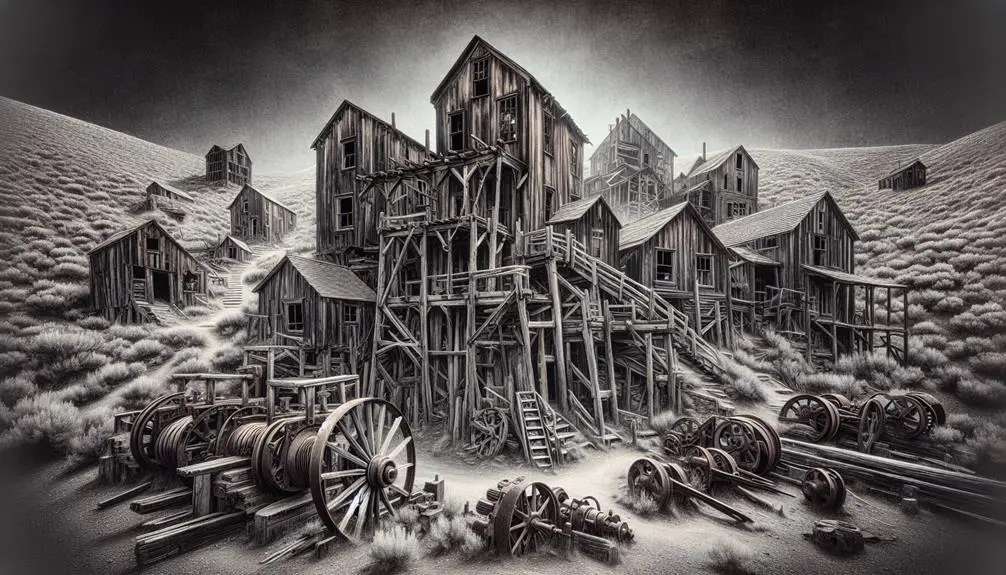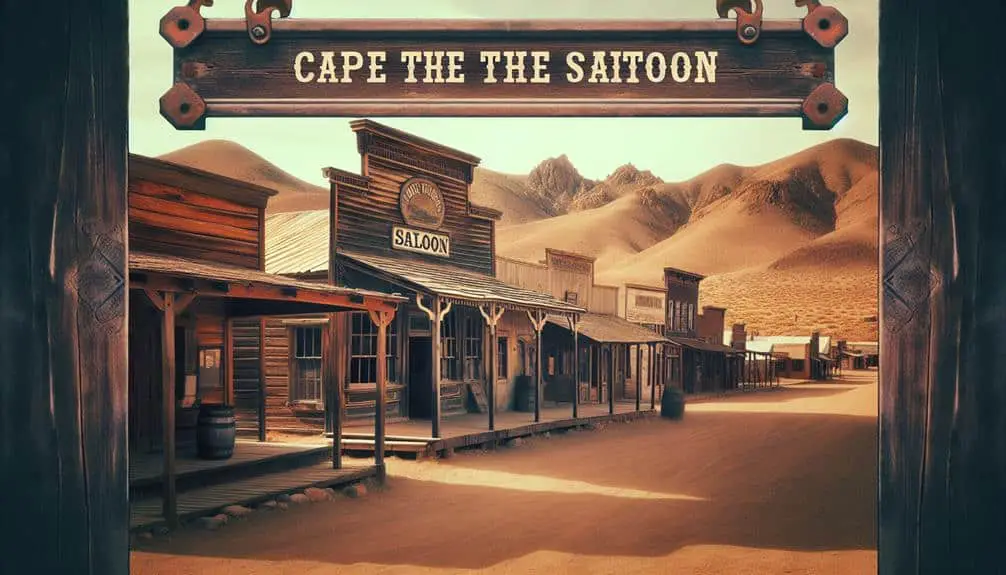Pioneer settlements in Arizona vanished due to a mix of environmental changes, economic struggles, and the lasting impacts of mining. These communities faced challenges like floods, droughts, and economic shifts that led to their decline. Mining activities reshaped the economic landscape, causing environmental harm and creating a boom-and-bust cycle in towns. The interplay of factors like population shifts and infrastructure limitations further contributed to their disappearance. Exploring these aspects sheds light on why these settlements disappeared, revealing a complex web of circumstances that influenced their fate. The intriguing history of Arizona's ghost towns awaits discovery.
Key Points
- Environmental changes, like floods and droughts, impacted sustainability.
- Economic decline and infrastructure limitations affected community viability.
- Mining activities altered landscapes and caused economic fluctuations.
- Population shifts and competition for resources influenced settlement dynamics.
- Natural disasters and abandonment trends led to the decline of pioneer settlements.
Early Settlements in Arizona
Early settlers in Arizona braved harsh conditions and rugged terrain to establish the first pioneer communities in the region. Native interaction played an essential role in shaping these early settlements. The pioneers learned from the indigenous peoples about sustainable agricultural practices suited to the arid landscape, such as irrigation techniques and crop selection, which were essential for the success of their communities.
Through their interactions with the Native Americans, the pioneers were able to adapt and thrive in an environment that initially seemed hostile. Agricultural development was a focal point for these early settlements, as they relied on farming not only for sustenance but also for trade with neighboring communities. The knowledge shared by the indigenous peoples enabled the pioneers to cultivate crops successfully and establish a foundation for economic growth.
The collaboration between the settlers and the Native Americans regarding agricultural development highlights the importance of cultural exchange and mutual respect in the establishment of pioneer communities in Arizona. This early history of cooperation laid the groundwork for the development of the region and set a precedent for future interactions between different groups seeking freedom and prosperity.
Factors Contributing to Decline
A variety of factors have contributed to the decline of the pioneer settlements in Arizona, shedding light on the challenges faced by these once-thriving communities.
- Environmental Changes: Harsh environmental conditions, including droughts and water scarcity, posed significant challenges to the sustainability of pioneer settlements in Arizona.
- Economic Decline: The shift in economic activities, from agriculture to mining, led to a decline in the agricultural sector, impacting the economic viability of these settlements.
- Infrastructure Limitations: Limited access to essential infrastructure such as transportation routes and communication networks hindered the growth and development of pioneer communities.
- Population Shifts: As mining activities grew in prominence, many residents left pioneer settlements in search of better economic opportunities, leading to a decrease in population and a subsequent decline in these communities.
These factors, including environmental changes and economic decline, played a pivotal role in the gradual disappearance of pioneer settlements in Arizona, highlighting the intricate interplay between various challenges faced by these early communities.
Impact of Mining Activities
The growing prominence of mining activities in Arizona greatly altered the economic landscape of pioneer settlements, exacerbating the challenges they already faced. As miners flocked to the region in search of valuable minerals like copper, silver, and gold, the environment suffered from significant degradation. The extraction processes led to widespread deforestation, soil erosion, and water pollution, impacting the livelihoods of settlers who relied on the land for farming and grazing.
Furthermore, the influx of mining operations brought about economic repercussions for the pioneer communities. While some settlers found employment in the mines, many others struggled as competition for resources increased, driving up prices and making it harder to sustain their way of life. The boom-and-bust nature of mining towns also contributed to instability, with periods of prosperity often followed by sudden declines, leaving settlers vulnerable to economic downturns.
Natural Disasters and Abandonment
Natural calamities and their aftermath played a pivotal role in the eventual abandonment of pioneer settlements in Arizona. The harsh and unpredictable nature of floods and droughts often led to devastating consequences, forcing pioneers to reassess their choice of settlement.
Four key points to ponder in the context of natural disasters and abandonment are:
- Impact of Floods: Flash floods in Arizona could wipe out crops, destroy infrastructure, and jeopardize the safety of residents, making it challenging to sustain a settlement.
- Drought Conditions: Prolonged periods of drought made it difficult for pioneers to access sufficient water resources for daily living and agriculture, ultimately leading to the demise of settlements.
- Struggle for Survival: Coping with the aftermath of natural disasters demanded immense resilience and resources, which many settlements lacked, accelerating their decline.
- Abandonment Trends: As natural disasters became recurrent, the trend of abandonment grew, with pioneers seeking more sustainable and secure locations to rebuild their lives.
Legacy of Arizonas Ghost Towns
Examining the enduring impact of Arizona's Ghost Towns reveals a complex tapestry of historical significance and cultural heritage. These abandoned settlements, frozen in time, serve as windows into the past, offering valuable insights into the challenges faced by early pioneers in the region. The preservation of these ghost towns is essential for maintaining Arizona's rich history and heritage.
Cultural preservation efforts play an important role in safeguarding the legacy of these ghost towns. By protecting and maintaining the remaining structures, artifacts, and stories associated with these settlements, future generations can continue to learn from and appreciate the pioneers who once called these places home.
Moreover, the tourism potential of Arizona's Ghost Towns shouldn't be overlooked. These eerie yet fascinating sites attract visitors from near and far, offering a unique opportunity to experience a piece of the Wild West's history. By promoting responsible tourism, these ghost towns can't only generate economic benefits for local communities but also raise awareness about the importance of preserving our cultural heritage for the generations to come.
Frequently Asked Questions
What Were the Main Sources of Entertainment in Pioneer Settlements in Arizona?
In pioneer settlements in Arizona, social gatherings and community events were key sources of entertainment. People gathered for dances, picnics, and religious gatherings. Outdoor activities like horseback riding and hunting also filled leisure time.
How Did the Pioneer Settlers in Arizona Interact With Native American Tribes in the Area?
You interacted with Native American tribes in Arizona through trade, mutual defense, and cultural exchange. Relationships varied, from cooperation to conflict, shaping both pioneer settlers and indigenous communities. These interactions influenced settlement patterns and social dynamics.
What Were the Most Common Occupations of the Residents in These Pioneer Settlements?
In those bustling pioneer settlements of Arizona, folks wore many hats! From wrangling cattle to tending crops, the occupational diversity was wild. But when the sun set, community gatherings united them under the desert stars.
Were There Any Notable Historical Figures or Events Associated With the Pioneer Settlements in Arizona?
Notable figures like John C. Fremont and events such as the Gadsden Purchase shaped pioneer settlements in Arizona. Cultural exchange and conflict resolution with Native American tribes were significant aspects of the region's history.
How Did the Architecture and Infrastructure of Pioneer Settlements in Arizona Differ From Modern Towns and Cities?
In pioneer settlements in Arizona, architectural styles were simplistic, reflecting basic functionality. Society's norms dictated a close-knit community with shared spaces. Contractions weren't common, and infrastructure focused on essentials rather than modern amenities seen in today's towns.



